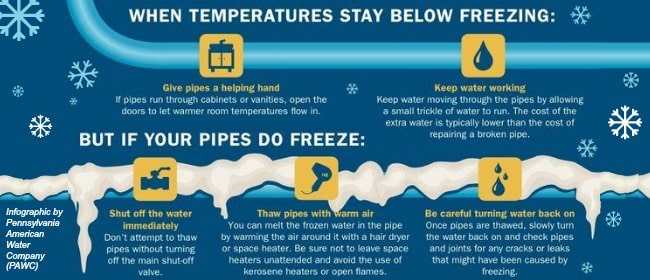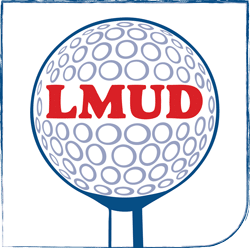Tips for Thawing Frozen Pipes

The first step you need to take is to shut off your water at the main shutoff valve, usually located at your water meter somewhere near the street, and open (turn on) all of your faucets (inside and outside). This step is very important because what causes burst pipes is the build up of pressure in the lines; opening the faucets will help release that pressure once the pipes thaw.
How do I know if my pipes are frozen?
First, temperatures outside typically need to be below 32 degrees Fahrenheit for pipes to have the potential of freezing.
The first indicator of frozen pipes is that you have lost your water supply or it is flowing slower than usual, but your neighbors still have water. If your neighbors are also out of water, it could be that your water provider has cut water to the neighborhood; contact your provider for updates.
Try turning on all of your faucets. If some of them have flowing water while others don’t, you have a localized issue that is not impacting your entire plumbing system. If some water is coming out, although slowly, leave it running; sometimes this is enough to melt the ice in the line. If there is no water, try to trace the plumbing line from that faucet back to where your water line comes into your home to determine where the blockage is located. It will most likely be in an uninsulated area.
If all of your faucets don’t have water when you turn them on, your main service line out in your yard (carries water from your water meter at the street to your foundation) could be frozen. This will only occur in extreme cold situations, typically below 20 degrees Fahrenheit with or without windchill.
What should I do if my pipes are frozen?
The first step you need to take is to shut off your water at the main shutoff valve, usually located at your water meter somewhere near the street, and open (turn on) all of your faucets (inside and outside). This step is very important because what causes burst pipes is the build up of pressure in the lines; opening the faucets will help release that pressure once the pipes thaw.
How do I thaw my pipes?
We repeat: keep your faucets open and your water turned off while pipes thaw! Keeping the faucets open will also expedite the thawing process and allow the thawing ice to run through the pipes.
While it is important to try to thaw a frozen pipe as quickly as possible to avoid further damage, doing so yourself does come with risks. If possible, locate the section of pipe that is frozen and thaw it yourself using gentle heat (slowly warm it up). If you heat the pipes up too quickly, they can crack or melt due to the quick change in temperature! Try wrapping an electronic heating pad around the pipe, heating the area with a hair dryer, or both. Towels soaked in hot water will help as well. Apply until water runs normally.
If possible, locate the section of pipe that is frozen and thaw it yourself using gentle heat (slowly warm it up). If you heat the pipes up too quickly, they can crack or melt due to the quick change in temperature!
If you cannot locate the location of the blockage, increasing your home’s temperature may help (above 55 degrees Fahrenheit). Open all cabinet and closet doors to increase the temperature in these enclosed spaces. If you suspect that there are pipes in or above the garage, use space heaters to heat up that space as well. Make sure to keep heaters away from anything potentially flammable!
Your pipes will eventually begin to thaw on their own once the temperatures rise above freezing. As they do so, you may begin to hear your pipes making gurgling, clanging, or banging sounds as the ice begins to move. The hot water heater may do the same.
Slowly turn water back on at the main shutoff value and inspect for leaks. If there are leaks, be prepared to turn the water off again immediately. If frozen pipes have cracked, homeowners may need to seek a plumber as soon as possible.
Can my irrigation system freeze too? What about my pool lines?
Yes and yes. It is best to winterize these systems in advance, but at minimum, turn off the system at the main controller. It’s also beneficial to shut off the system at your backflow device. If you have an above ground backflow device then be prepared for it to be busted. Make sure you know where to turn it off at.
Can my sewer lines freeze too?
This is very rare since typically only pressurized lines freeze, but it is possible. If there are foul odors escaping from your drains, it could indicate ice is blocking the drain. Follow the above recommendations for thawing the pipes.
Will my insurance cover the damage?
Until you are able to contact your property insurance agent for details, document everything, from the time you notice the problem and every step you take to repair it. According to The Balance Small Business, if you have the proper insurance, they should help cover some of these costs, but not all policies cover damage from frozen pipes. Some policies have specific requirements you must follow in order to be covered, such as maintaining the heat at a certain temperature in your home or shutting off the water supply during absence from your home to prevent a potential flooding issue. An insurance company wants to see that you took reasonable measures to prevent a problem from occurring.
How do I prevent my pipes from freezing in the future?
Unfortunately, infrastructure in southern states is not built for extreme cold, so rarely are your plumbing lines insulated well enough to handle below freezing temperatures for extended periods of time. For tips on how to prevent frozen pipes in the future, click here.

 You are now being redirected to the WaterSmart page.
You are now being redirected to the WaterSmart page.